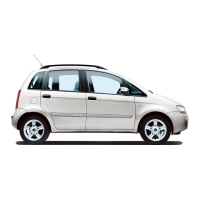
Do you have a question about the Fiat Idea and is the answer not in the manual?
| Brand | Fiat |
|---|---|
| Model | Idea |
| Category | Automobile |
| Language | English |
Information on how to refuel the vehicle correctly, including fuel types and octane ratings.
Procedure for starting the engine for petrol and Multijet versions, including key positions and checks.
Warning about parking the car on flammable materials due to catalytic converter heat.
Details of the instrument panel components like speedometer, fuel gauge, and rev counter.
Explanation of the electronic engine locking system for theft protection and key recognition.
Operation of the car key with remote control for ignition, door locks, and tailgate.
Instructions on how to engage and disengage the child lock for rear doors to prevent interior opening.
Explanation of the ignition switch positions (STOP, MAR, AVV) and safety features.
Description of the two-line modal display and its information, including odometer and clock.
Guide to the set-up menu for adjusting clock, buzzer volume, speed limit, and units.
Guide to operating external lights, including off, side/taillights, dipped beams, and main beams.
Guide to operating the cruise control system for maintaining a set speed.
How to operate hazard lights and front/rear fog lights.
Overview of various interior storage compartments, including upper, roof, and oddment compartments.
Guide to operating the sunroof, including anti-pinch system, clamping, and opening.
Instructions for operating electric windows, including automatic and manual functions.
Information on opening and closing the tailgate, including electric and manual methods.
Guide to opening and closing the car bonnet safely.
Instructions for using front and rear seat belts, including fastening, removal, and the S.B.R. system.
Explanation of the seat belt pretensioner system and its operation in a collision.
Guidelines for safely transporting children, including restraint system groups and recommendations.
Explanation of front airbags for driver and passenger, their protective function, and non-activation situations.
Information on side airbags and window bags, their protection, and proper usage.
Comprehensive guide to starting the engine, including procedures for petrol and Multijet versions, and jump-starting.
Instructions on how to park the vehicle safely, including handbrake usage and wheel positioning on slopes.
Guide to using the gearbox, including engaging gears, reverse, and 6th gear.
Suggestions for reducing running costs and emissions through car maintenance and driving style.
Important notes and procedures for towing trailers, including hitch installation and safety.
Information on using snow tyres, including size, pressure, performance, and legal requirements.
Precautions and steps for storing the car for longer than a month to maintain its condition.
General explanations of warning lights associated with specific messages and buzzers.
Indicates low brake fluid level, potentially due to leaks.
Signals a failure in the airbag system, requiring immediate attention.
Indicates low engine oil pressure or exhausted oil, requiring immediate attention.
Indicates EBD system failure or unavailability, potentially affecting rear wheel braking.
Signals a possible failure in the Fiat Code system, affecting engine start.
Explanation of generic warning lights and their common causes, like exterior lights failure or speed limit exceeded.
Indicates when the cruise control system is active.
Alerts the driver about a limited driving range or low fuel level.
Emergency engine starting procedures, including jump-starting.
Guide to using the quick tyre repair kit for temporary tyre repair.
Comprehensive guide to changing a car wheel, including general instructions and important notes.
Instructions for replacing fuses, including general information and fuse types.
Guide on what to do if the car battery is flat, including recharging procedures and safety warnings.
Procedures and safety precautions for towing the car, including removing tow hitch caps and fastening tow rings.
Explanation of the importance and requirements of scheduled servicing for maintaining car life and warranty.
A detailed schedule of maintenance tasks based on mileage intervals.
Guide to checking essential fluid levels in the engine compartment, with warnings about fluid compatibility.
Instructions for checking and topping up engine oil, including consumption rates.
How to check and top up engine coolant levels, including recommended mixtures and safety precautions.
Guide to wheels and tyres, including pressure checks, wear, replacement, and important notes.
Advice on protecting the car's bodywork from atmospheric agents and corrosion.
Instructions for cleaning interior parts, seats, upholstery, and plastic surfaces.
Information on vehicle identification codes, including model plate, chassis, paint, and engine markings.
Detailed technical specifications for different engine types, including power, torque, and fuel.
Technical details of the service brakes (front and rear) and parking brake system.
Information on wheels, rims, tyre data, spare wheels, and wheel geometry.
Vehicle dimensions expressed in mm, including luggage compartment volume.
Top permissible speeds for different engine versions after initial car use.
Table of vehicle weights, including unladen weight, payload, permissible loads, and towable loads.
Table showing fluid capacities for the engine, gearbox, brakes, and washer systems.
Fuel consumption figures determined by homologation tests, categorized by urban, extra-urban, and combined cycles.
An alphabetical index of topics covered in the manual for quick reference.